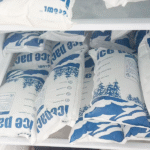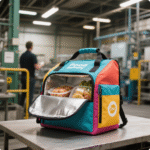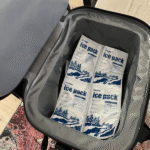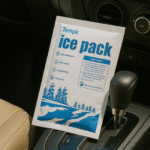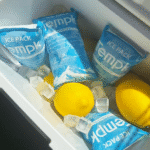Whether you’re going on a camping trip, shipping a batch of food to a client, or just need to store perishables in a power outage, dry ice packs for coolers are your best bet for maintaining a safe, cold temperature. Dry ice offers an extra layer of protection beyond regular ice packs, ensuring your products stay frozen and fresh for much longer. This guide covers everything from sizing your dry ice to the best packing methods, and all the 2025 shipping compliance updates.
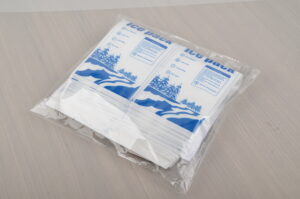
This Guide Will Answer:
-
How much dry ice do you need to keep food and drinks cold for up to 48 heures?
-
How to pack dry ice safely in coolers and avoid CO₂ hazards?
-
What are the latest shipping guidelines for dry ice in coolers (Iata, POINT, OMS)?
-
How to safely use dry ice in coolers for shipping food and medical items?
-
What is the best way to avoid dry ice burns and ensure safety?
-
How to size dry ice packs for coolers?
How Much Dry Ice Do You Need for Coolers?
Réponse courte:
For coolers, dry ice typically requires 2–3 pounds of dry ice per cubic foot of cooler space for up to 48 heures. Full coolers maintain cold temps longer, so you’ll need more ice if the cooler is half-full. Dry ice is much colder than regular ice, and its sublimation rate (how quickly it turns to gas) depends on the cooler type, ventilation, and outside temperatures.
Explication élargie:
Dry ice is an excellent choice for coolers because it sublimates directly from solid to gas, absorbing a large amount of heat during the process. It doesn’t leave water behind like regular ice. For most applications, a standard 20–30lb dry ice pack can keep coolers cold for around 48 heures. Cependant, you can adjust the weight depending on factors such as cooler size, qualité de l'isolation, and external temperature. Always err on the side of more dry ice, as you can always ventilate excess CO₂, but you can’t “create” dry ice once it’s gone.
Quick Guide to Dry Ice Sizing for Coolers
| Taille plus froide | Glace sèche (lbs) | Temps de maintien estimé | What this Means for You |
|---|---|---|---|
| 5–10 ft³ cooler | 8–10 lb | ~24–36 hours | Ideal for 1–2 day use, perfect for personal camping trips or food transport. |
| 15–20 ft³ cooler | 20–25 lb | ~36–48 hours | Best for extended trips, larger events, or shipping perishable foods. |
| 30+ ft³ cooler (expédition) | 30–50 lb | ~48 hours | For shipping bulk foods, vaccins, or medical goods, adding more ice ensures safety. |
Pour la pointe: Always test your dry ice size in advance, as it can vary based on the cooler’s insulation and opening frequency.
How to Safely Pack Dry Ice in Coolers?
Réponse courte:
Ensure the cooler has proper ventilation, Ne jamais sceller la glace sèche dans un emballage hermétique, and always handle it with insulated gloves or tongs. Dry ice releases carbon dioxide (Co₂) comme il sublime, so it’s important to allow the gas to escape. Sealing it in airtight containers can lead to pressure buildup, which could be dangerous. Make sure you always use vented coolers or packouts.
Explication élargie:
Dry ice requires careful packing. The key steps are:
-
Ventilation: Always use a cooler with vents or leave a crack in the lid to let CO₂ escape.
-
Superposition: Pack dry ice on top of your items, with cardboard or bubble wrap as a barrier. This ensures that items don’t get frozen directly and that the dry ice can release gas freely.
-
Protection: Handle dry ice using insulated gloves or tongs to avoid frostbite. Never place your bare skin on it.
When packing for shipping purposes, always mark the package with UN 1845 and make sure you label it as containing Dry Ice with a Class 9 étiquette de danger. This ensures safe transport and proper handling by shipping carriers.
Packing Checklist
-
Vented cooler or pack-out box
-
Insulated gloves and tongs
-
Layered packing (emballage de bulle, carton) between dry ice and food items
-
Dry ice amount: ~2.5–3 lb per ft³ of cooler volume
-
Marquage: Apply UN 1845, poids net (kg), et classe 9 label on the outer side
-
Thermometer or data logger for monitoring temperature
How to Ship Dry Ice in Coolers: Iata 2025 Lignes directrices
Réponse courte:
When shipping dry ice, make sure to use vented packaging, label the container with UN 1845 and Class 9 étiquettes, and include the net weight of dry ice in kilograms. Complying with IATA guidelines (Instruction d'emballage 954) ensures that your shipment is safe, especially in air transport. Le 2025 regulations emphasize proper venting, correct documentation, and safe packaging to prevent CO₂ hazards.
Explication élargie:
The International Air Transport Association (Iata) regulates the shipping of dry ice under Packing Instruction 954 (PI 954). Here’s what you need to do:
-
Package Ventilation: Always use packaging that allows CO₂ to escape. This is typically done through vented packaging with holes or relief valves.
-
Étiquetage: Mark the container clearly with UN 1845 (“Glace sèche / dioxyde de carbone, solide”), and specify the net weight of dry ice in kilograms.
-
Hazardous Goods Label: Afficher la classe 9 label to indicate the presence of hazardous materials.
-
Documentation d'expédition: Complete the Air Waybill and indicate the quantity of dry ice in the appropriate field.
For most air shipments, ensure compliance with the IATA Dangerous Goods Regulations (DGR) to avoid fines and delays. When shipping biologicals or perishables, you may need a specialized dry ice shipping box that meets IATA’s standards.
Best Practices for Air Shipments
-
Proper documentation: Fill in all details accurately, especially the net dry ice weight and Class 9 étiquette.
-
Venting is critical: Ensure all coolers have venting, as dry ice expands into CO₂ gas.
-
Avoid using glass containers: Dry ice can cause glass to crack under pressure.
FAQ
Q1: How much dry ice do I need for a 10 ft³ cooler?
You need about 25–30 lbs of dry ice to keep it cold for 48 heures. Make sure to place dry ice on top of the items for optimal cooling.
Q2: Can dry ice be used for shipping food in coolers?
Oui, dry ice is ideal for shipping perishable items, especially frozen foods. Make sure to label the package with UN 1845 and the correct Class 9 shipping label.
Q3: How do I safely use dry ice in a cooler?
Always handle dry ice with insulated gloves and never seal it in an airtight container. Ensure the cooler has ventilation to allow CO₂ gas to escape.
Q4: Is dry ice safe for shipping medical items?
Oui, dry ice is commonly used for shipping medical items, but ventilation and labeling are required for safety. Follow IATA PI 954 guidelines and mark UN 1845 clearly.
Résumé & Recommandations
Points clés:
Dry ice packs for coolers offer extended cold retention and are the ideal solution for shipping and storing perishables, nourriture, et les fournitures médicales. Always size your dry ice based on the cooler size, pack it correctly with ventilation, and adhere to 2025 IATA guidelines for shipping. Always use gloves when handling dry ice and ensure proper labeling and ventilation.
Étapes suivantes (actionable):
-
Calculate your dry ice requirement for your cooler or shipment.
-
Check all coolers for ventilation and ensure compliance with safety regulations.
-
Label the shipment correctly using UN 1845 et classe 9 étiquettes.
-
Test and calibrate your dry ice shipping procedures every 6 mois.
À propos du tempk
Tempk is a leading supplier of cold chain packaging solutions. We design and manufacture dry ice packs for coolers and medical shipping solutions that meet IATA standards. Our products are tailored to your needs, ensuring compliance, sécurité, and temperature control every time.
Contact us today for a consultation on dry ice packs for coolers—we’ll help you determine the best packaging for your needs!
















